Saratoga Horticultural Research Foundation
Changing California’s Landscape 1951-2006
In 2006, the Saratoga Horticultural Research Foundation donated its archives to Special Collections along with funds to process the collection. Processing of the collection is now complete and the collection is fully available to researchers. This exhibit showcases the Saratoga Horticultural Research Foundation Collection and chronicles the Foundation’s role in creating ornamental landscapes perfectly suited to California’s challenging climates.
Early Years

The Saratoga Horticultural Research Foundation (SHRF) was founded in 1952 by a group of horticulturalists and nurserymen committed to improving western horticulture. Named after the location of its original headquarters on Verde Vista Lane in Saratoga, California, the SHRF grew out of nurseryman Ray Hartman’s vision of a horticultural experiment station for developing hardy, reliable trees and shrubs for the California landscape. Hartman engaged his longtime friend Maunsell Van Rensselaer, a horticulturalist, and a handful of others interested in examining the possibility of establishing an experiment station as a foundation.
First Foundation building under construction, 1951
The Saratoga Horticultural Research Foundation was ultimately established as a non-profit organization under the direction of a Board of Trustees, which was advised by a Board of Councilors drawn from prominent figures in the fields of western horticulture, arboriculture, landscape design, and botany. The Foundation’s activities were advised by a director who reported to the Board of Trustees. During their fifty-four years, the Foundation introduced several new cultivars of magnolia, California lilac, and manzanita, and strongly promoted the use of drought-tolerant landscaping.
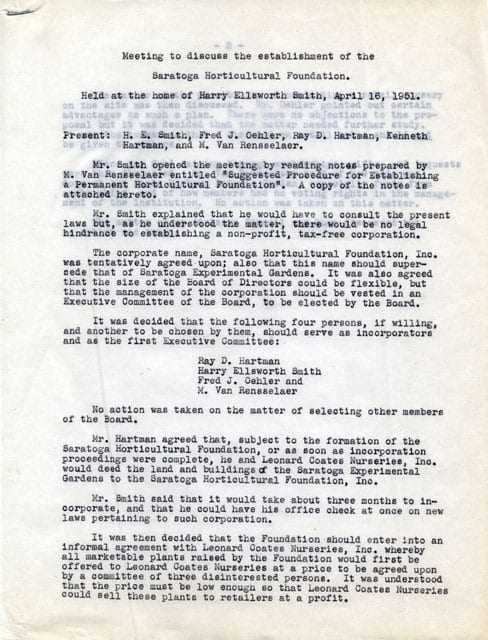
Saratoga Horticultural Research Foundation: Meetings to establish the Foundation began in 1951
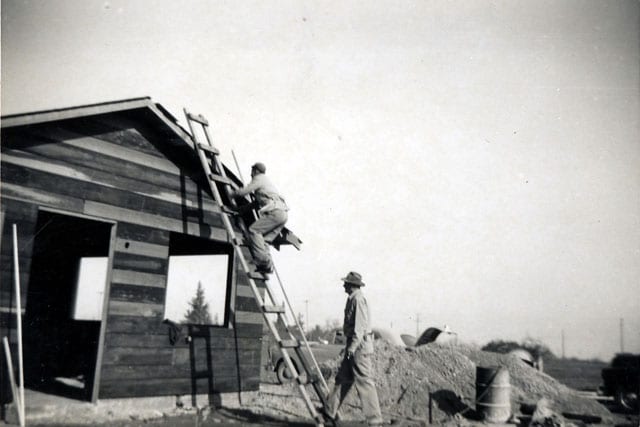
Saratoga Horticultural Research Foundation: First Foundation building under construction, 1951
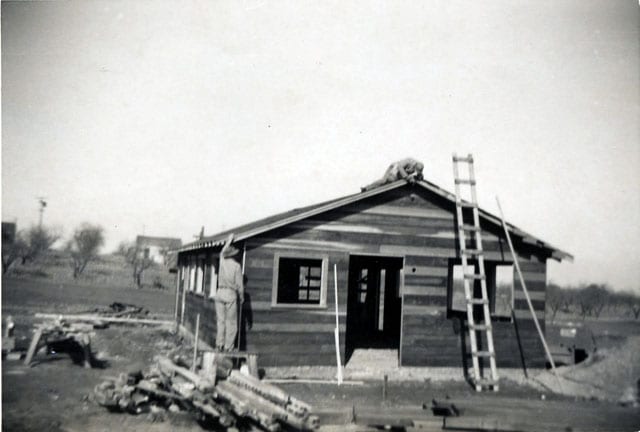
Saratoga Horticultural Research Foundation: First Foundation building under construction, 1951

Saratoga Horticultural Research Foundation
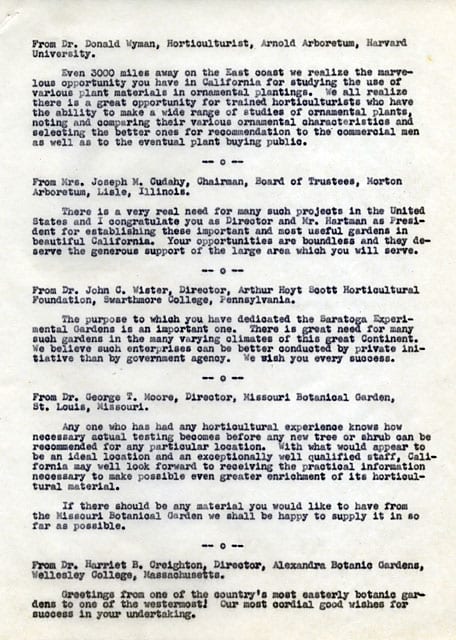
Saratoga Horticultural Research Foundation
Research
The SHRF was instrumental in developing the ornamental landscaping familiar to Californians today. The Foundation conducted research into plant quality and propagation methods, evaluated trees and woody plants for street and shade planting, established test sites for investigations into climate and cultural techniques, and ultimately patented varieties of magnolia, Chinese pistache, and olive trees. The Foundation also investigated plants from Australia, New Zealand, and Chile as potential low-water-use and fire-retardant introductions to California gardens.
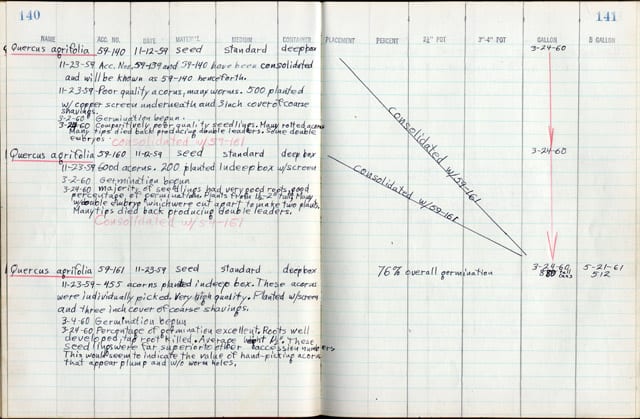
Saratoga Horticultural Research Foundation: Horticultural Record, 1960 Horticultural Record, 1960

Saratoga Horticultural Research Foundation: Photographing specimens
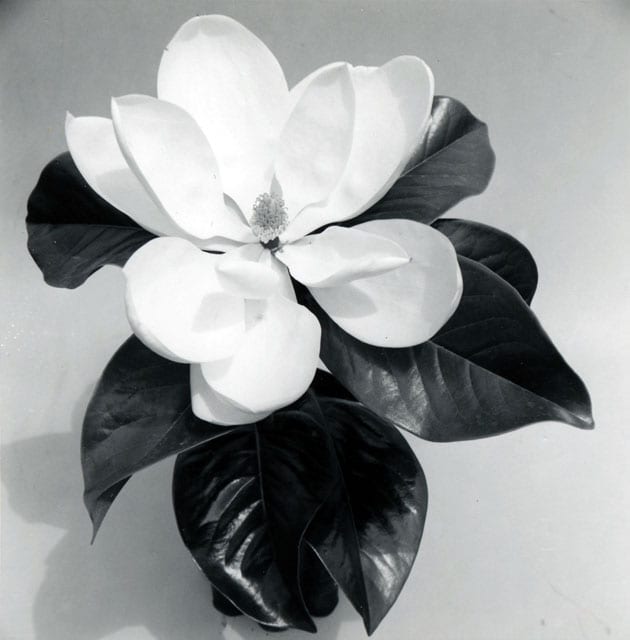
Saratoga Horticultural Research Foundation: Magnolia grandiflora “Samuel Sommer”
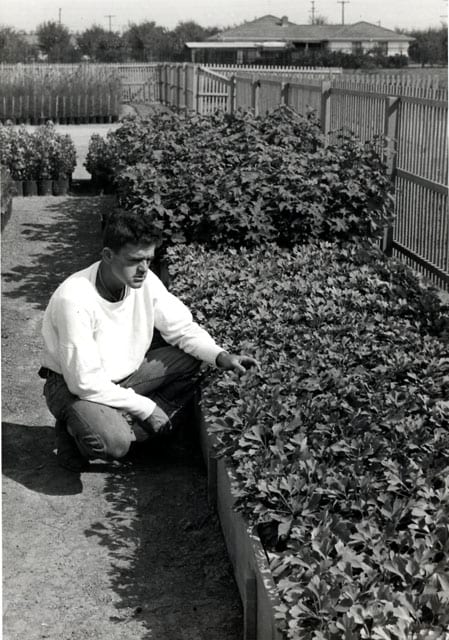
Saratoga Horticultural Research Foundation: Year-old Ginkgo biloba seedlings in nursery
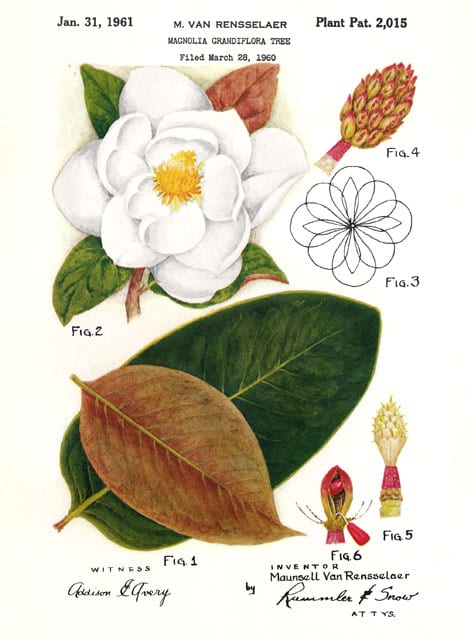
Saratoga Horticultural Research Foundation: Patent for Magnolia grandiflora “Samuel Sommer”

Saratoga Horticultural Research Foundation: Patent for Pistachia chinensis “Keith Davey”

Saratoga Horticultural Research Foundation: Dwight Long, Horticultural Consultant
Ornamental and Shade Trees
Among the well-known plants and trees the Foundation promoted for home and commercial landscaping are: Liquidambar “Palo Alto” and Ginkgo biloba “Autumn Gold,” which provide brilliant red and yellow fall foliage; several varieties of Ceanothus, or California lilac, known for its spikes of purple and blue flowers; and the many varieties of Manzanita commonly used in hedges and ground covers.
One of the SHRF’s major activities was the selection and promotion of street trees. The Foundation sought out hardy, attractive trees that would blend with the landscape and thrive with little maintenance.

Saratoga Horticultural Research Foundation: Parent tree of Ginkgo biloba “Autumn Gold”
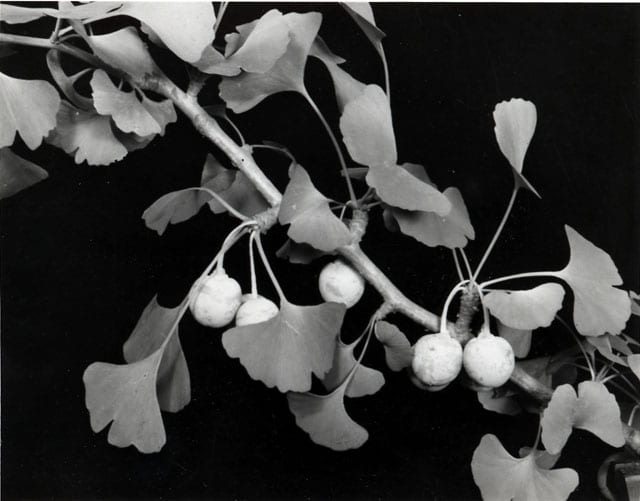
Saratoga Horticultural Research Foundation: Leaves and fruit of Ginkgo biloba “Autumn Gold”
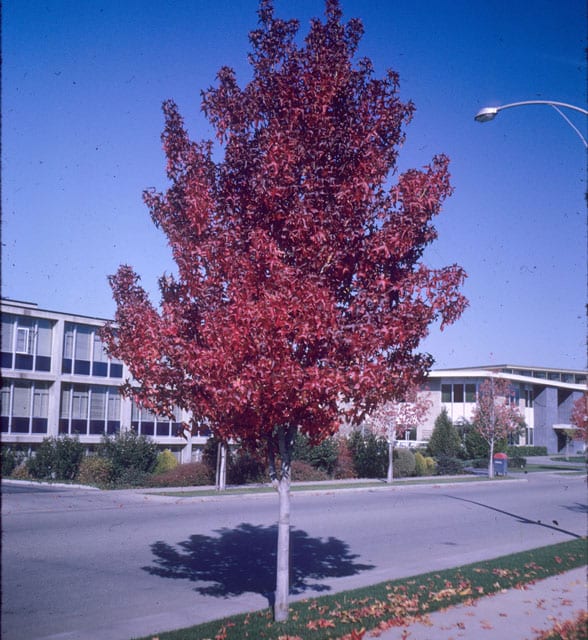
Saratoga Horticultural Research Foundation: styraciflua “Palo Alto”

Saratoga Horticultural Research Foundation: Parent tree of Pistachia chinensis “Keith Davey”

Saratoga Horticultural Research Foundation: Ceanothus “Frosty Blue”

Saratoga Horticultural Research Foundation: Arctostaphylos manzanita “Dr. Hurd”
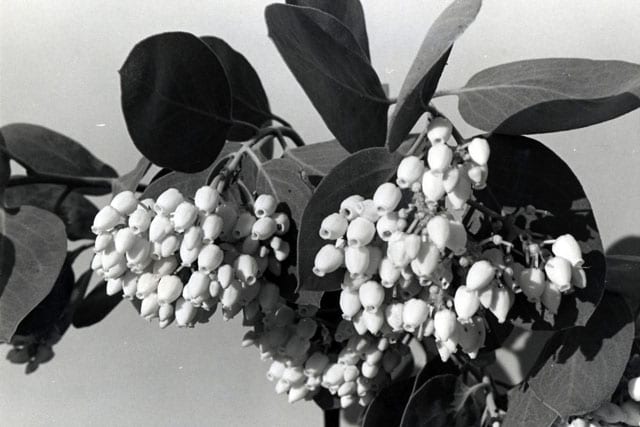
Saratoga Horticultural Research Foundation: Arctostaphylos manzanita “Dr. Hurd”
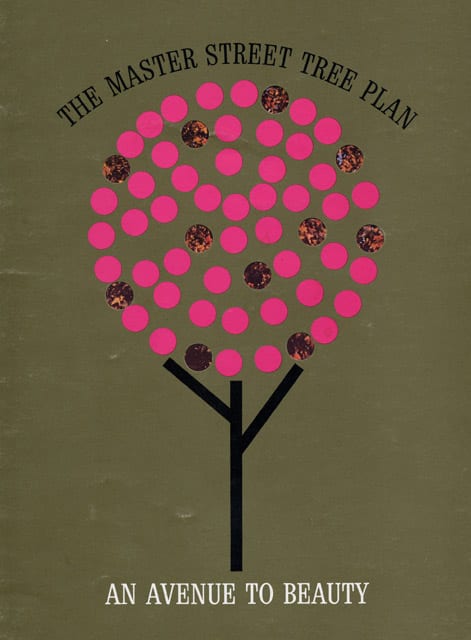
Saratoga Horticultural Research Foundation

Saratoga Horticultural Research Foundation
Drought-tolerant Landscaping
During the mid-1970s, a period of drought struck the Sacramento and San Joaquin Valleys. In response to the increased need for water and energy conservation, the Foundation expanded its mission to include the promotion of drought-tolerant landscaping. It encouraged the use of California native plants and trees, shade trees to maximize cooling, and alternative plantings for heavily-watered areas.
“Today there is a growing change in attitude and a common understanding that we cannot continue using water resources as if they were unlimited. … With this in mind, Californians have begun to look beyond their garden walls to the hillside, valley, and seashore to discover where plants grow naturally — taking into account soil, rainfall, and exposure.”
A California-Style of Gardening, Dennis White.
The Foundation actively evaluated and promoted native and other low-water-use plants and trees.
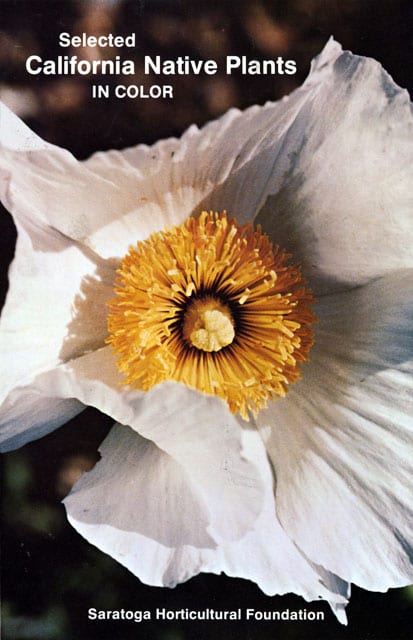
Saratoga Horticultural Research Foundation: Selected California Native Plants in Color, Saratoga Horticultural Research Foundation, 1980
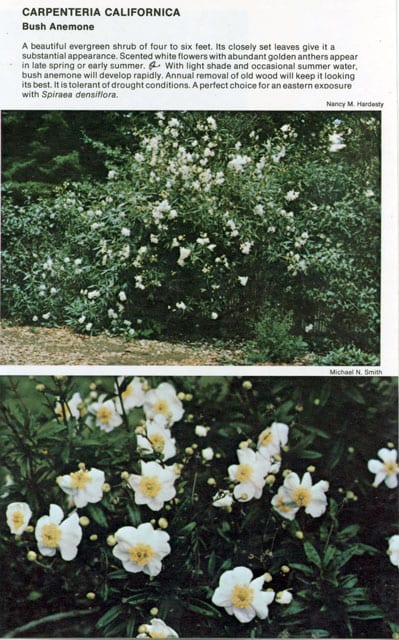
Saratoga Horticultural Research Foundation
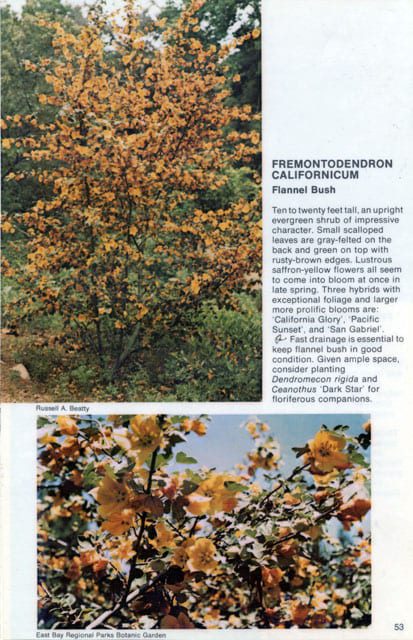
Saratoga Horticultural Research Foundation
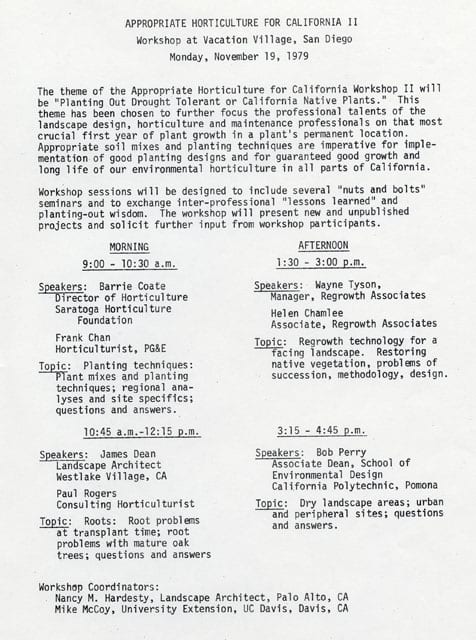
Saratoga Horticultural Research Foundation
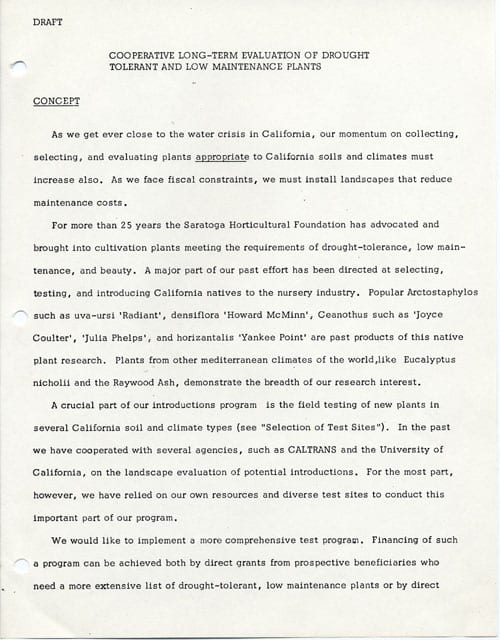
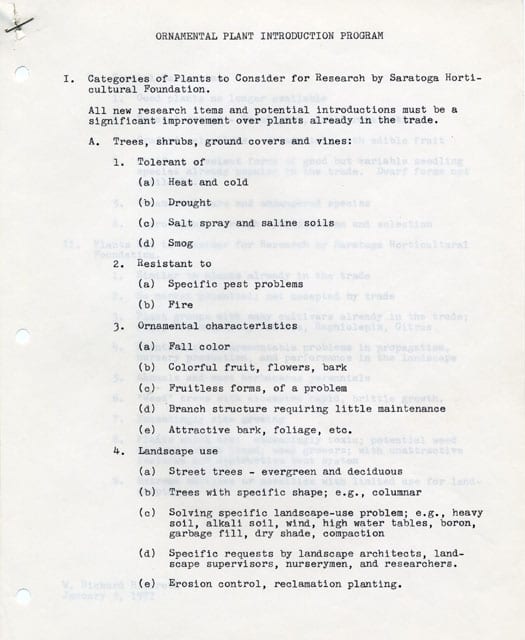
Saratoga Horticultural Research Foundation
Outreach and Education
Associates of SHF newsletters: 1976, 1986, 1989, 1991
At the height of its membership, the Saratoga Horticultural Research Foundation had approximately 400 members engaged in research, educational outreach, and promotion of selected cultivars. The Foundation provided the findings of its research to members of the nursery trade, landscape architects, students, teachers, and other researchers.
The Foundation was known for its spring plant sales and Fall Festival, during which the public could tour the Foundation’s nursery and purchase native and unusual plants. Most of the outreach activities were coordinated and carried out by the Associates of Saratoga Horticultural Foundation, the SHRF’s docent and fund-raising group.
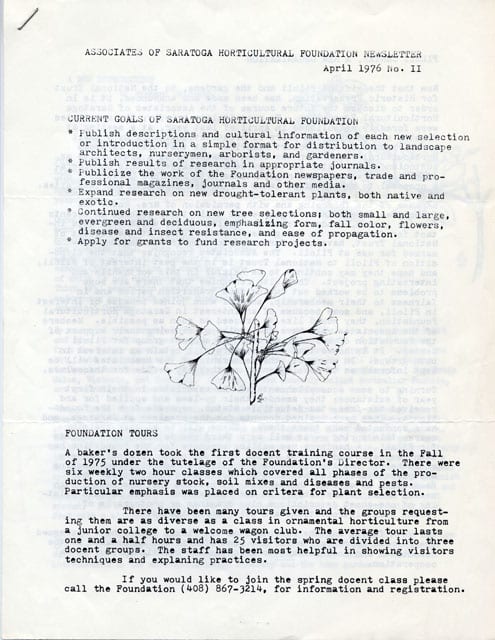
Saratoga Horticultural Research Foundation: Associates of SHF newsletter
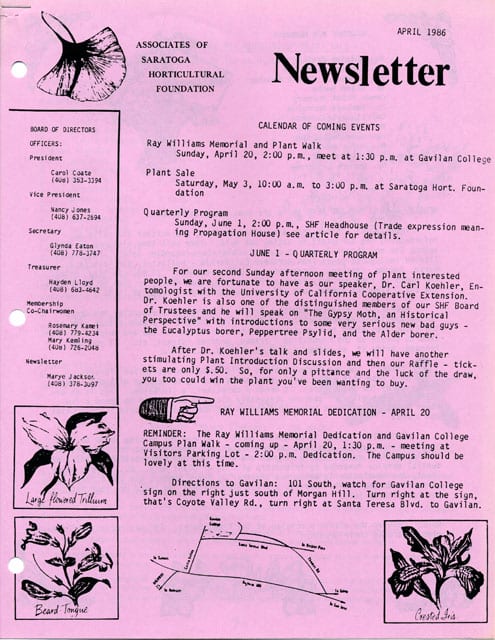
Saratoga Horticultural Research Foundation: Associates of SHF newsletter

Saratoga Horticultural Research Foundation: Associates of SHF newsletter

Saratoga Horticultural Research Foundation: Associates of SHF newsletter

Saratoga Horticultural Research Foundation: Fall Festival, circa 1990
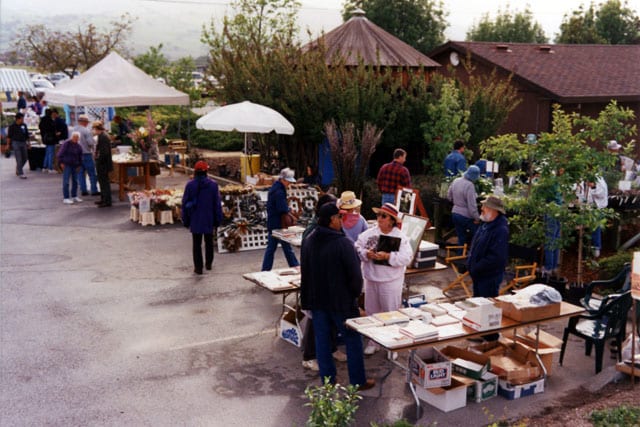
Saratoga Horticultural Research Foundation: Fall Festival, circa 1990
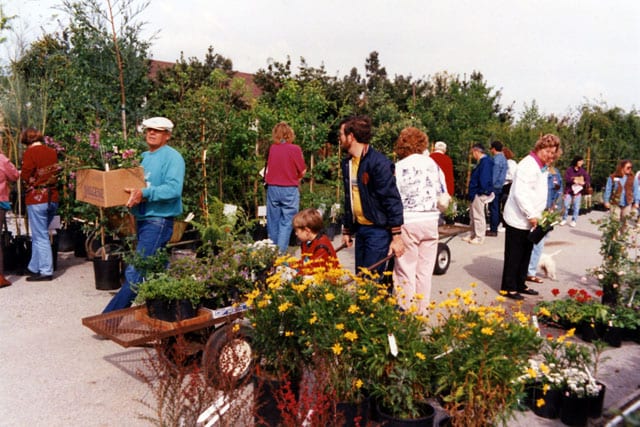
Saratoga Horticultural Research Foundation: Fall Festival, circa 1990

Saratoga Horticultural Research Foundation: Associates Nursery Tour with Barrie Coate, Director of Horticulture, 1985

Saratoga Horticultural Research Foundation: Associates Nursery Tour with Barrie Coate, Director of Horticulture, 1985

Saratoga Horticultural Research Foundation: Group Tour Outline from an early Associates docent training program, 1976
Saratoga Horticultural Research Foundation’s Legacy
“New Endowment Established at UC Davis to Support Horticultural Research and Education”, College of Agricultural and Environmental Sciences
When the Foundation elected to disband in 2006, it had met its mission of raising interest in California native plants and creating an ornamental landscape perfectly suited to California’s Mediterranean climate zones. The Foundation’s fifty-four years of activity were essential in guiding nurseries to continue the Foundation’s work to select, evaluate, and introduce climate-appropriate plants to the California landscaping and gardening public.
This guide draws on the Foundation’s legacy of researching and promoting strong, well-chosen street and shade trees.
Some nurseries specialize in California-appropriate plants and trees.
The Department of Special Collections is very grateful to the Saratoga Horticultural Research Foundation for their generous donation in support of the processing and promotion of this collection.
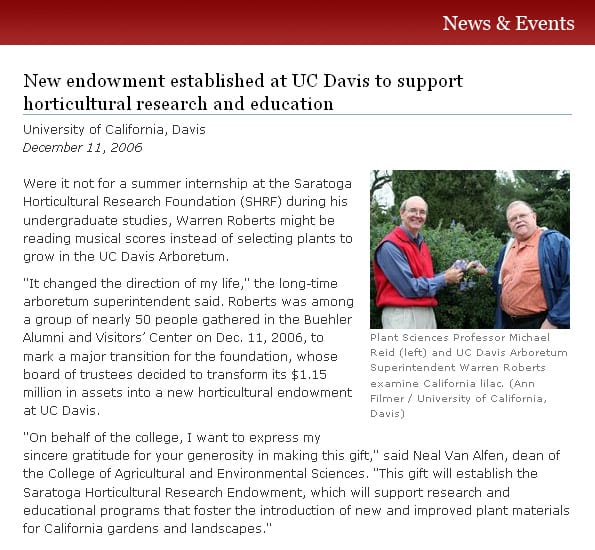
Saratoga Horticultural Research Foundation

Saratoga Horticultural Research Foundation: Carol and Barrie Coate’s notes for speeches given at UC Davis, December 2006

Saratoga Horticultural Research Foundation: Treescapes at UC Davis, prepared by Amy Davis and the UC Davis Grounds Division, 1995.

Saratoga Horticultural Research Foundation: Catalogs from collection O-009, Nursery Catalogs, United States
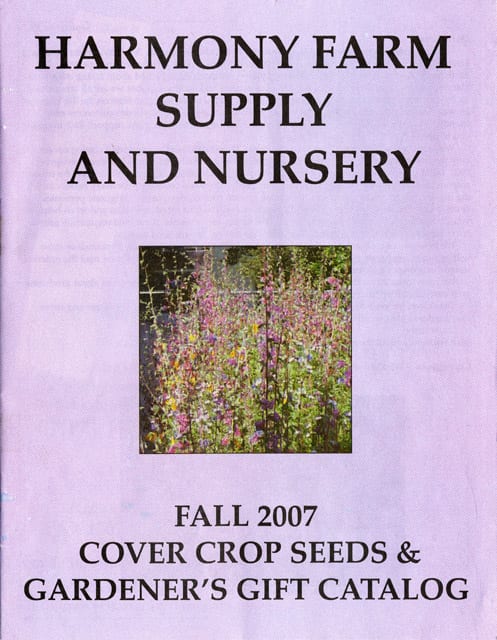
Saratoga Horticultural Research Foundation: Catalogs from collection O-009, Nursery Catalogs, United States
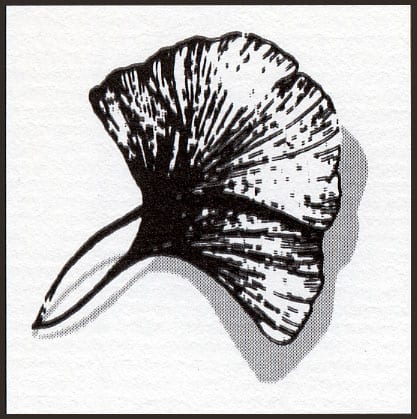
Saratoga Horticultural Research Foundation
SHRF Collection: Plant Culture Data Sheets
© Saratoga Horticultural Research Foundation, Inc.
This information is provided by permission of Ing. Robert de Bree, Director of SHRF, Inc.
The finding aid for the Saratoga Horticultural Research Foundation Collection is available at the Online Archive of California.
For more information, please contact Special Collections, (530) 752‑1621, speccoll@ucdavis.edu.
The Plant Culture Data Sheet project began in 1985 under the direction of Director Phillip McMillan Browse. This project continues in an effort to provide more information about the various selections that have come through the Saratoga Horticultural Research Foundation Program. Over time, the decision was made to not update the data sheets, but, rather to present them in a historical sense reflecting the earliest dates of cultivar introduction. This information has been culled from the files of the Foundation and will be added to as more information is found and processed. As a benefit of membership, periodically our newsletter will announce new data sheets as they become available.
- Abies bracteata
- Arbutus x “Marina”
- Arctostaphylos: California Native Manzanitas
- Arctostaphylos: Manzanita Introductions by SHRF with additional notes on:
- Arctostaphylos “Dr. Hurd”
- Arctostaphylos “Emerald Carpet”
- Arctostaphylos densiflora “Howard McMinn”
- Arctostaphylos hookeri “Monterey Carpet”
- Arctostaphylos x “Sunset”
- Artemisia californica “Canyon Gray”
- Carpenteria californica
- Ceanothus Introductons by SHRF, including:
- Quick I.D. Hints on Ceanothus
- Ceanothus Species Description
- Ceanothus “Dark Star” | Ceanothus “Julia Phelps” | Ceanothus “Ray Hartman”
- A new ceanothus cultivar: “Olwlswood Blue”
- Ceanothus gloriosus “Anchor Bay”
- Ceanothus x “Frosty Blue”
- Ceanothus griseus “Louis Edmunds”
- Ceanothus griseus var. horizontalis “Yankee Point”
- Ceanothus x “Joyce Coulter Ceanothus “Julia Phelps”
- Ceanothus “Ray Hartman”
- Celtis
- Chinese Pistache
- Chitalpa tashkentensis “Pink Dawn”
- Coprosma “Verde Vista”
- Correa “Carmine Bells”
- Correa “Ivory Bells”
- Dicliptera suberecta
- Eriogonum crocatum
- Eriogonum latifolium ssp. grande var. rubescens
- Eucalyptus bauerana
- Eucalyptus gunnii, cider gum
- Eucalyptus nicholii, willow-leaved peppermint
- Eucalyptus spathulata
- Fraxinus oxycarpa “Raywood”
- Fremontodendron “California Glory”
- Fremontodendron “Pacific Sunset”
- Fremontodendron “San Gabriel”
- Galvezia Speciosa “Bocarosa”—Island Bush Snapdragon
- Garrya elliptica
- Geijera parviflora
- Genista pilosa
- Ginkgo biloba “Autumn Gold”
- Ginkgo biloba “Saratoga”
- Hebe “Amy”
- Isomeris arborea—Bladderpod
- Lagerstroemia, three new, mildew resistant Crape Myrtles
- Laurus “Saratoga”
- Liquidambar styraciflua
- Liriodendron tulipifera
- Loropetalum chinense
- Magnolia grandiflora
- Mahonia nevini—Nevin’s Mahonia
- Maytenus boaria “Green Showers”
- Notes on Metasequoia
- Myoporum
- Myrica californica
- Populus fremontii “Nevada”
- Prostanthera rotundifolia rosea (Round Leaf Mint-bush)
- Prunus ilicifolia (Hollyleaf-cherry)
- Quercus lobata—Valley Oak
- Raphiolepis bellata “Minor”
- Rhamnus californica “Eve Case”
- Ribes sanguineum
- Ribes sanguineum “White Icicle”
- Ribes viburnifolium
- Romneya coulteri
- Rosmarinus officinalis “Ken Taylor”
- Salvia clevelandii “Aromas”
- Salvia mellifera “Terra Seca”
- Salvia regia “Royal”
- Sapium sebiferum
- Scaevola “Mauve Clusters”
- Sequoia sempervirens
- Tristania laurina, water gum
- Umbellularia californica
- Viburnum plicatum